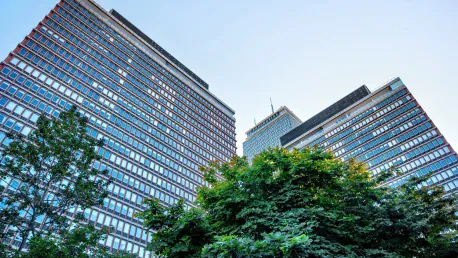The U.S. Green Building Council (USGBC) has been at the forefront of transforming the built environment to align with sustainability goals for the past three decades. Their efforts have not only established green building standards but also mobilized a global community dedicated to sustainable practices. This article delves into the significant strides made by USGBC and the impact of their initiatives on the green building industry.
The Birth and Evolution of LEED
Establishing a Benchmark for Green Building
Introduced in 1998, the Leadership in Energy and Environmental Design (LEED) green rating system has become a benchmark for building standards. LEED-certified projects are designed to save more than 120 million metric tons of CO2 emissions, showcasing their environmental impact. Over the years, LEED has guided the creation of high-performing, healthy, and resilient structures, making green buildings a global priority. The system’s emphasis on sustainability extends beyond energy efficiency, incorporating water use reduction and improved indoor environmental quality, which in turn promotes healthier living and working spaces.
LEED has proven to be a flexible framework, adapting over time to address the diverse needs of green building projects across different sectors. From homes and schools to the largest skyscrapers, the framework provides a comprehensive approach to building design, construction, and operation that is both environmentally responsible and resource-efficient. This adaptability ensures that as new sustainability challenges emerge, LEED can evolve to meet those needs without compromising its core mission of promoting green, healthy, and resilient building practices worldwide.
Expanding Reach and Influence
With over 195,000 LEED projects in 186 countries, the reach of LEED is extensive. The system has certified a total of 29 billion square feet of space, including more than 547,000 residential units and over 330 cities and communities. This widespread adoption illustrates the significant role green building practices play in striving toward global sustainability objectives. LEED’s influence can be seen in the way it shapes construction practices and policies internationally, encouraging the use of sustainable materials and innovative design approaches that minimize environmental impact.
The proliferation of LEED-certified projects is a testament to the growing global recognition of the importance of sustainable building solutions. This widespread acceptance has, in turn, driven market transformation. Property owners and developers increasingly recognize the value of LEED certification, not only as a mark of environmental stewardship but also as a means to enhance long-term asset value, reduce operating costs, and improve occupant satisfaction. These developments demonstrate LEED’s role in reshaping industry standards and influencing building codes to promote sustainable development on a global scale.
Impact on Various Sectors
Transforming Education and Communities
LEED’s influence extends to educational institutions, with 5,000 certified schools impacting eight million students. This transformation ensures that educational environments are not only sustainable but also conducive to learning and health. By improving air quality, utilizing natural lighting, and incorporating energy-efficient systems, LEED-certified schools create healthier environments that are beneficial to both students and staff. These enhancements contribute to better academic performance and improved well-being, making sustainable schools essential in shaping the future.
Additionally, LEED-certified cities and communities demonstrate the system’s ability to foster sustainable urban development. By promoting practices such as green infrastructure, reduced carbon footprints, and resource conservation, these communities serve as models of sustainability. LEED’s framework encourages urban environments to integrate green spaces, enhance public transport systems, and reduce waste, creating more livable, equity-focused, and resilient cities. These principles not only improve residents’ quality of life but also ensure the long-term sustainability of urban areas.
Corporate and Organizational Adoption
The green building community includes 5,300 USGBC member organizations, ranging from large corporations to small businesses, local governments, and research institutions. Each organization plays a crucial role in USGBC’s vision of creating environments where buildings operate in harmony with nature. This diverse adoption underscores the universal applicability of LEED standards. By integrating sustainable practices into their operations, these organizations set a precedent for others in their sectors and contribute to a broader cultural shift toward sustainability.
Corporations and government bodies adopting LEED standards demonstrate their commitment to corporate social responsibility and environmental stewardship. The benefits of these green initiatives extend beyond the immediate environmental impact. Organizations report lower operational costs due to efficient energy and water use, a healthier workforce leading to reduced absenteeism, and positive public perception, which can enhance their brand image. These advantages reinforce the importance of sustainable operations and drive further adoption across all levels of society.
Specialized Programs and Innovations
Adapting to Diverse Needs
LEED has rolled out specialized programs to address the unique characteristics of different types of buildings and sectors. These targeted initiatives ensure that new constructions, existing buildings, neighborhoods, and entire cities can all meet high standards of sustainability. For instance, LEED for Homes focuses on residential properties, ensuring that sustainable building practices are applied to everyday living spaces. Similarly, LEED for Schools addresses particular needs of educational institutions, from enhanced air quality to improved daylighting.
The evolving system now stretches across homes, schools, skyscrapers, and more, reshaping industry standards and influencing building codes. By offering customized certification tracks for diverse project types, LEED caters to a wide range of design, construction, and operational needs. This enables the accommodation of unique challenges faced in different environments, such as those in urban areas versus rural settings, ensuring that all buildings can achieve meaningful improvements in sustainability and resilience regardless of their starting point.
Introduction of PERFORM
In addition to LEED, USGBC recently introduced PERFORM, a program designed to help organizations enhance sustainability across their real estate portfolios. PERFORM offers a solution for companies with climate goals by helping them track and benchmark sustainability progress effectively, regardless of building type or initial condition. This program provides a comprehensive set of tools for measuring energy usage, water consumption, and overall environmental impact, enabling organizations to make data-driven decisions to improve their sustainability performance.
PERFORM is expected to significantly propel companies toward achieving their organizational performance goals. By providing insights into operational efficiencies and resource management, the program helps organizations identify areas for improvement and implement strategies that align with their sustainability targets. This initiative not only supports corporate environmental goals but also fosters a culture of continuous improvement, encouraging ongoing innovation and commitment to green building practices within the real estate sector.
Building a Global Community
Cultivating Green Building Professionals
A significant focus of USGBC’s efforts has been to cultivate a global community of green building professionals. This has been achieved through decades of courses, credentialing, events, and volunteer opportunities. With over 205,000 credential holders worldwide, this network has driven industry transformation by linking experts to opportunities to further sustainable practices and innovations. These professionals play a pivotal role in promoting LEED standards and advocating for best practices in sustainable building design, construction, and operation.
USGBC’s educational initiatives have created a knowledgeable and skilled workforce capable of leading the transition to a more sustainable built environment. Through continuous professional development, green building professionals stay abreast of the latest advancements in sustainability, allowing them to implement cutting-edge solutions in their projects. This ongoing education ensures that the green building community remains dynamic and responsive to emerging environmental challenges, fostering a culture of innovation and excellence.
Shaping Policy and Markets
The influence of the USGBC community extends well beyond physical structures. The global community has not only shaped policy but also shifted markets towards sustainable and healthy materials. This collective effort has inspired professionals and demonstrated that the built environment can be a leader in fostering a better future. Policymakers have increasingly incorporated LEED principles into regulations and building codes, promoting widespread adoption of sustainability standards at local, national, and international levels.
The market shift towards sustainable materials and practices has been driven by the demand for LEED certification, influencing manufacturers and suppliers to prioritize eco-friendly products. This trend has not only improved the availability and affordability of sustainable building materials but has also driven innovation within the industry. As a result, the construction sector has seen a significant reduction in its environmental footprint, contributing to global efforts to mitigate climate change and protect natural resources.
Future Directions and Strategic Plans
USGBC’s 2024 Strategic Plan
Looking ahead, USGBC’s 2024 Strategic Plan aims to build on the achievements of the past 30 years. The plan is concentrated on expanding the green building community, accelerating the decarbonization of economies via buildings, and fostering communities that are equitable, healthy, and resilient. This forward-thinking approach ensures that USGBC remains at the cutting edge of sustainability efforts. By setting ambitious goals and outlining clear strategies, the 2024 plan aims to further integrate sustainability into the fabric of the built environment.
The strategic plan emphasizes collaboration with a diverse range of stakeholders, from industry leaders and policymakers to local communities and educational institutions. By fostering partnerships and encouraging knowledge sharing, USGBC aims to create a holistic approach to sustainability that addresses the complex interdependencies between buildings, natural systems, and human well-being. This comprehensive strategy is designed to inspire collective action and drive meaningful progress toward a sustainable future.
Launch of LEED v5
For the last three decades, the U.S. Green Building Council (USGBC) has been a pioneering force in transforming the built environment to meet sustainability goals. Their efforts have not only set high standards for green building but also engaged a global community committed to sustainable practices. The USGBC has spearheaded numerous initiatives to promote environmental responsibility, energy efficiency, and the use of sustainable materials in construction. Through their leadership, they’ve catalyzed a shift in how buildings are designed, constructed, and operated, ensuring a more sustainable future. This article explores the substantial advancements made by the USGBC and examines how their initiatives have significantly influenced the green building industry. From their development of the LEED certification program to their advocacy and educational efforts, the USGBC’s impact has been profound, driving a worldwide movement towards more environmentally friendly and sustainable building practices. Their work continues to inspire innovation and foster a global commitment to creating healthier, more sustainable spaces.









